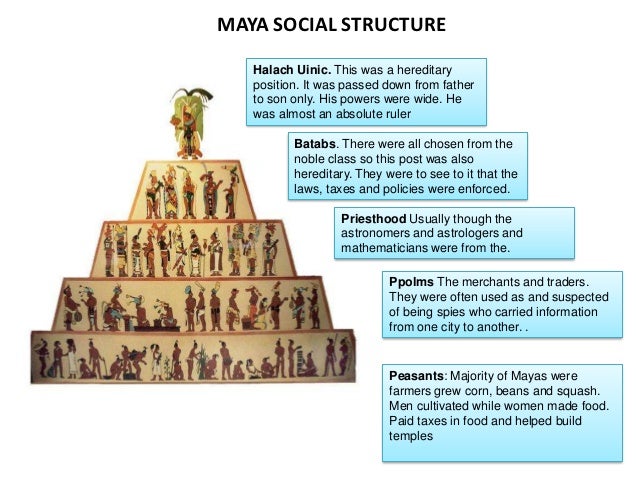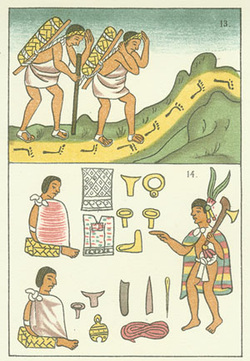The social structure in the Maya Empire was set. It was very difficult to move upwards. Status was usually hereditary. Occupations for Maya men was limited to their father's occupation. If your father was a farmer, you were a farmer. If your father made bricks, you made bricks. There were some exceptions, but they were rare. Women, however, could be involved in government, economics, and religion, as well as responsible for hearth, home, and children. Still, Maya women could not marry outside their social class.
Social Classes, the Caste System: A caste system is a very rigid social system in which you are born into a social position and cannot leave that position. In a caste system you are required to marry within your own caste. The upper caste was composed of rulers, nobles and priests. The middle caste were businessmen, merchants and soldiers. The lower caste was made up of farmers and slaves.
Rulers: Each city had a ruling family. That family lived a life of luxury. During religious ceremonies, rulers wore headdresses that were taller than they were. Rulers held hereditary positions. Sons inherited their right to rule from their fathers. The only way a new ruling family could take over would be by war. This is one reason fights and wars between Maya cities were common.
Nobles and Priests: The only people who could read and write in the ancient Maya world were most of the priests and some of the nobles.
Priests: The most powerful people in the ancient Maya Empire were not the ruling families; the most powerful were the priests. The common people brought the priests tributes or gifts and provided free manual labor for whatever they needed. They did this because the people believed the priests could talk to the Maya gods. Priests lived a life of luxury with servants and attendants. They usually lived away from the common people. Except at the major festivals, the people who supported the priests rarely saw them.
Nobles: Nobles did not have to pay taxes. They did not need to produce anything, although some had jobs. Those who wanted them were given jobs in civil service, as military leaders, and as business leaders in commerce and trade. Most nobles had a great deal of free time and lived lives of luxury.
Merchants and Craftsmen: The Maya didn't have a middle class, so merchants and craftsmen were either nobles or peasants creating art or running a business. For those craftsmen who were peasants, their life was a step up from the life of a farmer, but they could not act like or dress like a noble. They were peasants and if they forgot that, they risked death.
Peasants: Peasants made up the bulk of Maya society. Craftsmen lived in the cities. Farmers lived outside the cities, in their fields. Peasants worked very hard. They did not live a life of luxury. Peasants were used as human sacrifice if no other people, like captured warriors, were available.
Slaves: Slaves were the lowest level. In general, slaves were not treated poorly. In some cases, their lives were far more comfortable than the life of a farm family. But no matter how they were treated, slaves had no rights or privileges. Slaves could be orphans, captured people, or punished people - people who were serving a sentence as a slave. Most of the victims of human sacrifice were selected from the slaves.
Warriors: Warriors were special. They didn't fall into any class really except that of warrior. Military leaders came from the nobles. In the rank and file, some warriors were sons of warriors. Some warriors were peasants, pulled from the fields to fight, who remained in the military if they showed an aptitude for warfare. Some warriors were highly respected, and in some cases, honored. But there was a pecking order. If you were a peasant, you might become a warrior but you would never achieve the same rank as the son of a warrior, although your son might, because your son would be the son of a warrior.

INCAS
The Inca Empire was the largest empire during the days of the pre-Columbian America. The Inca civilization arose from the highlands of Peru during the early 13th century and the people were generally referred to as the Incas. The Incas considered their king to be the son of the sun and this king was known as the Sapa Inca.
The Incas followed a strict social hierarchy system and according to this system, there were 4 main levels which were the Sapa Inca, The Royalty, the Nobility and the Ayllu. To know more about what each of these levels meant, you can read the following given information:
Sapa Inca
The Sapa Inca was the most powerful person during the Inca civilization and in other terms, was the king of the Incas. The Sapa Inca was considered to be the son of the sun and was the wealthiest and most respected person. The Sapa Inca would have many wives and father many children. He had one primary wife who was known as the Coya. Coya was the full sister of Incas and this tradition was followed to maintain the royal blood.
Royalty
Besides the Sapa Inca or the king, the relatives and the royal family of the king were known as the Royalty and had a very high status in the society. They were the wealthiest and the most powerful people during the Incas civilization and enjoyed all the luxuries during those days. The descendants of the Sapa Inca were also royalty and had the chance to become kings in the future. The son of the Sapa Inca was called the Auqyi.
- Coya
- Auqyi
Nobility
Below the Royalty came the nobility which was the class of people who acted as leaders to govern over the rest of the Incas population. The nobles were also respected people who had certain privileges and enjoyed many freedoms. For example, these people were not required to pay taxes and also received gifts from others. This class was further subdivided into three other divisions which are given as follows:
- Capac Incans-highest ranking nobles
- Huhua Incans- these were not the true nobles but were still given the status and rights
- Curacas-these were the local leaders and collected taxes.
Commoners
Most of the Incas population belonged to the category of the commoners. These people took up low wage jobs like farming, herding and even worked as servants at the houses of the nobility or the royalty.
- Farmers
- Herders
- Servants
- slaves
https://www.hierarchystructure.com/incas-social-hierarchy/
Aztecs
The Aztec Empire had a strict social structure that was identified with nobles, commoners, serfs, or slaves. The social structure was also identified with boys and girls. Boys would receive a wider education than the girls and were taught how to fight and become a leader. Although, the girls were taught to cook, take care of a family, run a home and craft. The women did have a lot of power in the society but was mostly kept a secret.
The noble class had many privileges and the class is consist of government, military leaders, priests and lords. They had some wealth and were allowed to enjoy works of art unlike the common people. As a noble you were in the positions of leadership and influence of others. The noble class also received a fuller education and were allowed to wear fancy clothing and decorate their homes to show their status.
The noble class had many privileges and the class is consist of government, military leaders, priests and lords. They had some wealth and were allowed to enjoy works of art unlike the common people. As a noble you were in the positions of leadership and influence of others. The noble class also received a fuller education and were allowed to wear fancy clothing and decorate their homes to show their status.

The commoners were known as the macehualli and consist of farmers and merchants who would travel to trade. Both farmers and merchants had a fair amount of freedom and to be independent. Common people were also allowed to dress nice. They enjoyed the great amount of wealth they received and prestige within the class.
The serfs worked on land owned by the nobles and did not live in the calpulli. If the serfs fail to pay tribute would receive a punishment of becoming slaves for certain crimes. Many prisoners of war would become slaves if they were not used as human sacrifices.
The slaves had many rights in the Aztec Empire considering they treated the slaves well. The slaves had rights to marry, have children, substitute another in their place and buy freedom. The slave owner's had many responsibilities for the slave to make sure they would not be re-sold. The slave owner's were responsible of feeding the slave and having a sheather for the slave for housing.
The serfs worked on land owned by the nobles and did not live in the calpulli. If the serfs fail to pay tribute would receive a punishment of becoming slaves for certain crimes. Many prisoners of war would become slaves if they were not used as human sacrifices.
The slaves had many rights in the Aztec Empire considering they treated the slaves well. The slaves had rights to marry, have children, substitute another in their place and buy freedom. The slave owner's had many responsibilities for the slave to make sure they would not be re-sold. The slave owner's were responsible of feeding the slave and having a sheather for the slave for housing.
